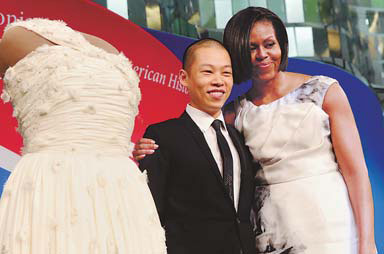Society
East in vogue as US puts on the style for export
By Kelly Chung Dawson (China Daily)
Updated: 2010-10-29 07:54
 |
Large Medium Small |
|
US first lady Michelle Obama poses with designer Jason Wu as she presents her 2009 inaugural gown to the Smithsonian's National Museum of American History on March 9, 2010. [Olivier Douliery / Abaca Press] |
Asian-American designers creating lines for Chinese shoppers. Kelly Chung Dawson reports from New York.
If the shows at New York Fashion Week highlighted one trend this year, it was the rise of Asian designers in the United States.
Up-and-comers like Phillip Lim, Thakoon Panichgul and Derek Lam proved hits this summer, which came hot on the heels of Richard Chai, Alexander Wang and Jason Wu being named the best of the new breed by the Council of Fashion Designers of America (CFDA).
"Asian designers who are getting more recognition are doing so because they have genuine talent," said Steven Kolb, executive director of the council. "The decision to honor designers with (our awards) is based on talent, and talent alone."
Although ethnicity did not factor in the CFDA awards, fashion experts suggest that rising stars of Asian heritage could have a distinct advantage when it comes to tapping into the growing markets for high-end fashion in the Far East, particularly China.
Sales of luxury goods in China alone reached roughly $9.4 billion in 2009, according to a report from Chinese Academy of Social Sciences, while PricewaterhouseCoopers, the global professional services firm, predicts China will become the biggest consumer of luxury goods by 2015.
Major foreign labels are attempting to capitalize on this growth, as well as similar trends across the region, with lines specifically tailored to Asian shoppers.
This year, Levi Strauss & Co released Denizen, a style of jeans targeted at 18 to 28-year-olds in China, South Korea and Singapore, while Hermes launched Shang Xia, clothes specifically designed for Chinese buyers, at its newly opened store in Shanghai.
The region plays an integral part in the plans of most Asian designers, too.
"It is a goal for every designer to be part of China's growing economy," said Prabal Gurung, a Nepalese fashion designer who has enjoyed critical acclaim in the US.
"The Chinese luxury market is becoming more and more important, if not as important as the European market," he said. "You would have to be a fool not to consider China. You would lose out on a lot of business."
Luckily for fashionists with Chinese lineage, they stand to profit from what Simon Collins, dean of the school of fashion at Parsons The New School for Design, or Parsons for short, believes is a growing sense of national pride in Chinese fashion design.
"It's starting to emerge that Chinese people seem to want to have things be of China," he said.
